Family : Pinaceae

Text © Prof. Paolo Grossoni

English translation by Mario Beltramini
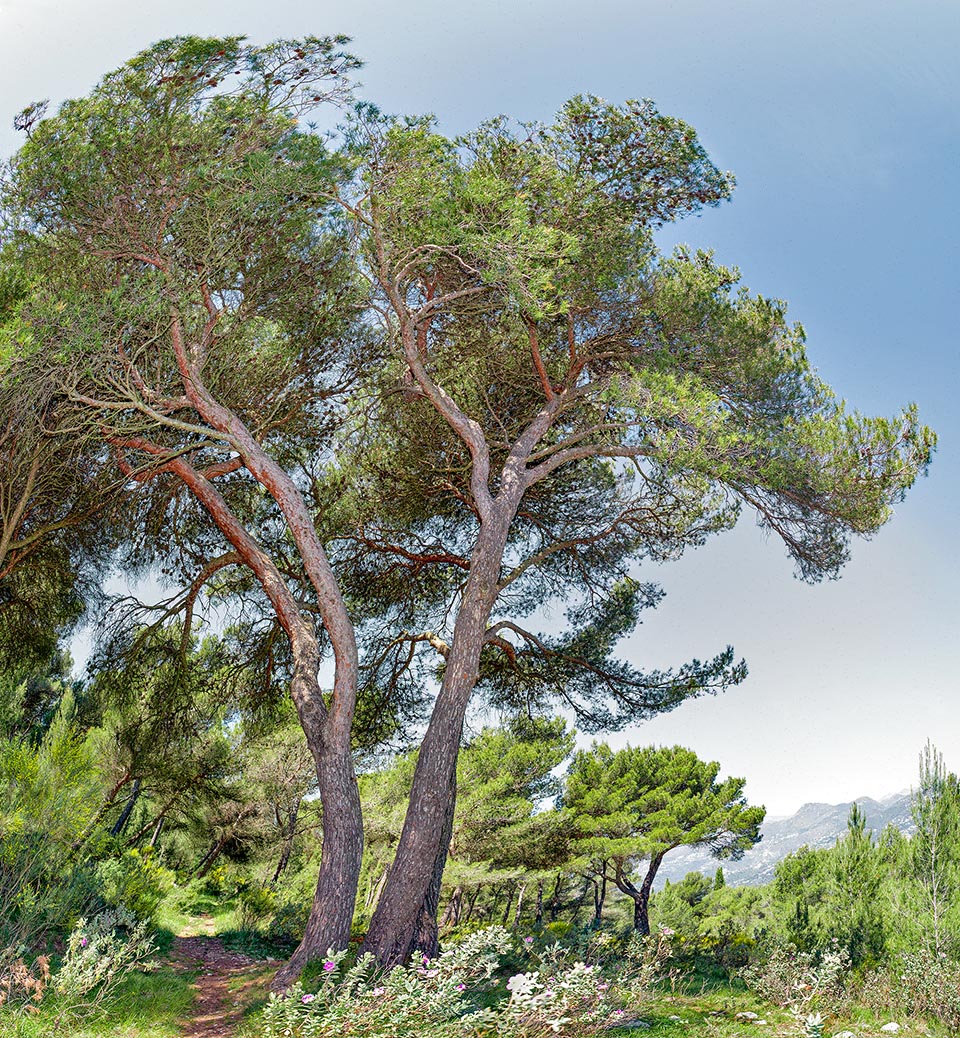
The picturesque Aleppo pine (Pinus halepensis) is a thermophile Mediterranean species that can be 15-20 (25) m tall with trunk and primary branches always more or less sinuous and with a very broad crown, before globose, then umbrella-shaped and discontinuous because subdivided in more lobes, often even deeply separated © G. Mazza
Pinus is the Latin epithet having the same Sanskrit root «pit–pítu» (resin) from which has also derived the substantives ‘Picea’. With 117-(119) species the genus Pinus L. (1753) is most numerous among the Conifers.
Pines are evergreen trees (rarely shrubs) with definitive needle-shaped leaves, that, depending on the species, can persist 2 to 40 years and reach lengths between 3-4 cm (P. banksiana Lamb.) and 20-30 cm or 20-45 cm in P. roxburghii Sarg. and in P. palustris Mill. The needles are clustered in fascicles of 2, 3, or 5 carried on specialized dwarf branch that have a basal sheat which may fall off or persist; the needles do not fall directly buti s the dwarf branch thatt comes off bringing to the ground the needles inserted. Excepting P. cembra L., a 5-needles pine, all other pines spontaneous in Italy have 2 needles per fascicle.
Pines are monoecious with anemogamous pollination and the “ripening” of sporophylls is spring The microsporophylls carrying the microsporangia, in which the pollen grains are formed, that are arranged in yellow to red axillary catkin-like conelets clustered in the basal portion of the year’s branchlet that is without needles (pratically “naked”) so as to facilitate the transport of pollen grains by wind.
Macrosporophylls are also arranged in cones, mostly solitary or in verticils, along the subapical part of the year’s branchlet; they are easily reachable by the pollen because during his release the needles are not completely elongated.
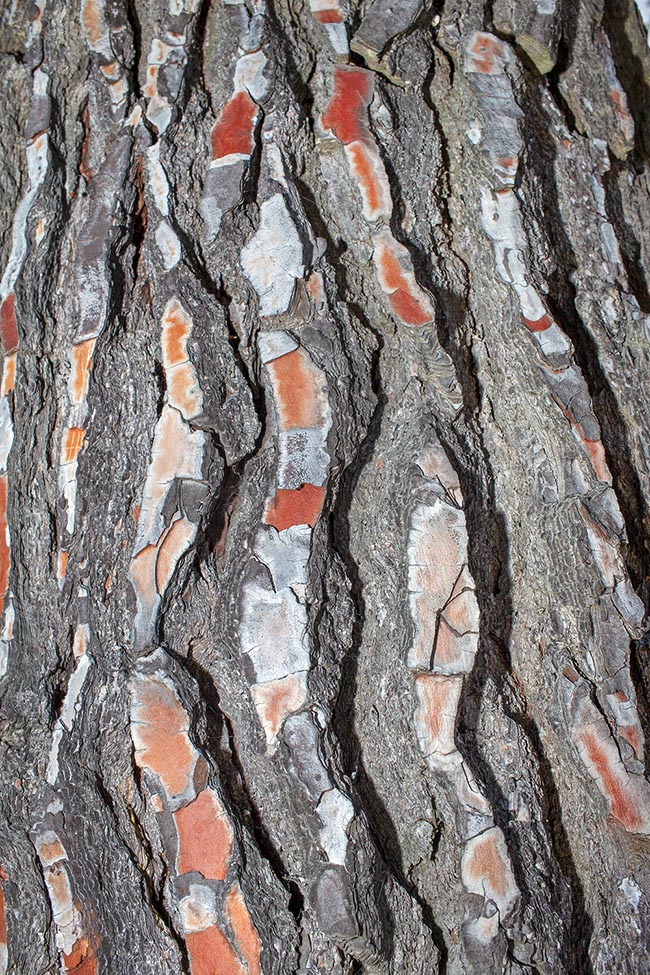
Close-up of a trunk of an adult pine. The suberificated outermost layer of bark, (rhytidome), which in the woody plants is protecting from heath excess, loss of water, entrance of parasites, and any bump, in Aleppo pine is at first ash gray and smooth then it cracks in reddish brown vertical plates which don’t flake off © Giuseppe Mazza
The ovuliferous scale bears two ovules on the upper surface that, after pollination, are protected by a covering bract; invece the male cones dry up and fall down leaving, as was previously stated, “naked” that trait of the branch.
The embryo is mature in the autumn of the second year (on the third year in P. pinea L. and in some pines of Mexico and California). During this time the cone has lignified and has even increased considerably; commonly it is called cone or pine cone or even pinecone and it has obviously a conical shape more or less elongated and simmetric. It is 2-3 cm long in P. mugo Turra or 25-50 cm in P. lambertiana Douglas and exceed in weight also 2-3 kg in P. coulteri D.Don (Robert Kral recommends to wear a helmet when under its plants).
The cone either disseminates from winter (‘deiscent cone’) or it remains closed even for several years. In many species, the seed is winged to be able to move further away from the mother plant, then the wing detaches easily. Germination may be immediate or seed has a dormancy even prolonged for several years that must be removed (i.e., the seed of P. cembra germinates two years after developing). Seedling is very characteristic because it has a high number (6-18) of long cotyledons.
Pines grow in all continents of the northern hemisphere from sea level to the limits of woody vegetation and from the tropical mountain regions up to beyond the Arctic Circle; only few species reach and exceed the equator on some mountain ranges of south-east Asia.
First pines date back to the Mesozoic, about 140 million of years ago (Early Cretaceous), but a few tens of millions later, at the beginning of the Later Cretaceous, the genus had already diversified in the actual two subgenera Pinus and Strobus; at the first (also called diploxylon because in all species the needles contain two fibrovascular bundles) belong the pines commercially called “hard pines” while in the second (aploxylon as being with a single fibrovascular bundle) belong to those called “soft” or “white pines”.
It is necessary to remark that to the American pine P. longaeva D.K.Bailey belong absolutely the oldest trees with ages ranging between 4500 and 4900 years. A 5062-year-old plant had recently been reported but the Rocky Mountain Tree-Ring Research, a non profit organization that provides expertise in tree-ring studies, stated that the results were too uncertain. With 1.229 years the oldest European pine is a Bosnian pine (P. heldreichii Christ var. leucodermis (Antoine) Markrgr that grows in the Pollino National Park (South Italy).
The specific name Pinus halepensis is due to the Scottish Philip Miller (1691-1771) who has been one of the most active and important botanist of the eighteenth century. He described it in 1768 calling it P. halepensis to highlight that «[…] grows naturally near Aleppo, and in several other parts of Syria.» (The Gardeners Dictionary. 8 ed., 1768) and this geographical epithet was rapidly absorbed in many languages as “pino d’Aleppo” in Italian, “pin d’Alep” in French, “pino de Alepo” in Spanish (where is employed also “pino carrasco”), “Alepski bor” in Croatian, “χαλέπιος πεύκη” in Greek, “Halep çami” in Turkish, “Aleppo Kiefer” in German, “Aleppo pine” in English and so on.
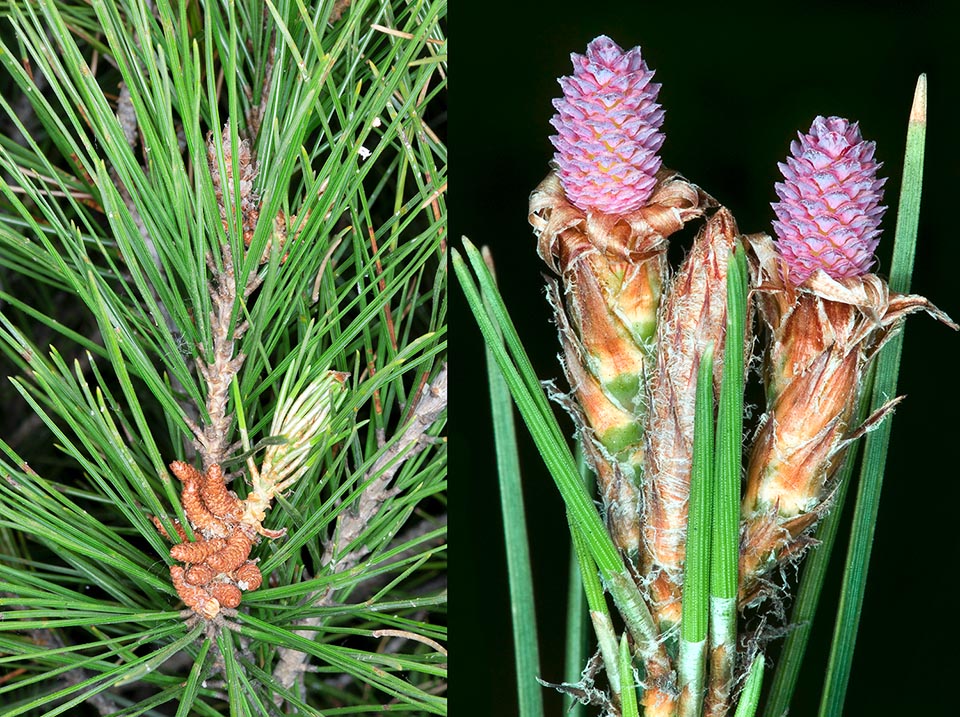
Needles are united in fascicles of two. Left, male cones that have already released their pollen grains; right, two female cones at time of pollination © Giuseppe Mazza
It is a tree that can reach a height of 15-20 (25) m with trunk and primary branches often more or less sinuous and with a very broad crown, at first globose, then umbrella-shaped but discontinuous because it is divided in even deeply separate lobes; the rhytidome (the outermost layer, suberificated and dead, which in the woody plants is protecting from heath excess, loss of water, entrance of parasites, and any bump) in Aleppo pine is at first ash gray and smooth then it cracks in reddish brown vertical plates which don’t flake off; the buds are ovoidal, 5-10 mm long, not resinous with scales, often reflexed, fringed with white at the edge.
The surface of the branchlet is covered by rudimentary leaves scale-like (‘euphylls’) rounded at apex, not photosynthetizing, and persistent for some years. The needles, in fascicles of two (exceptionally three), with a 7-8 mm persistent sheath, are thin (0.7-1 mm, the thinnest of the Italian pines), very slender, (5) 7-10 (12) cm long and pale green with grey-blue nuances; they remain on the branch for (2) 3 years. The root system is taproot but, over the time, the secondary roots become the most important as they can penetrate deeply into the ground, even in the cracks in the rocks.
Among the thermophilic Mediterranean pines, P. halepensis not only has the shortest juvenile stage, but is also the firs that in spring has reproductive organs ready for pollination (March-early April); the male cones are clustered at the base of the year’s branch, are oval, yellow with pink-red nuances and produce great quantities of pollen; the ovuliferous cones are widely oval, pink with violaceous nuances, are subapical, solitary or in verticils of 2-3, briefly pedunculated.
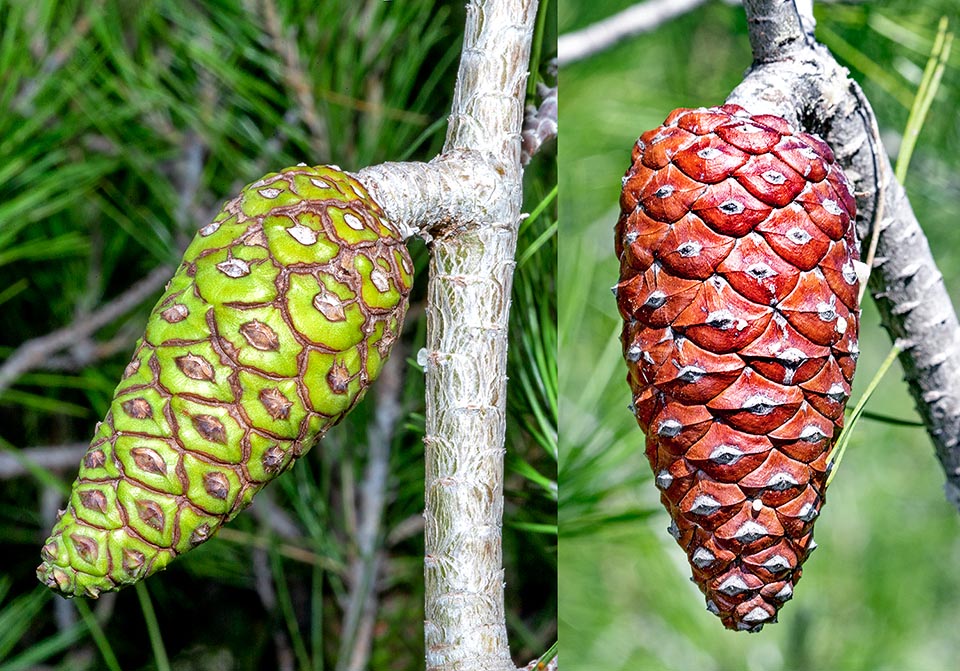
Left: Growing pinecone carried by solid peduncles on branchlets with clear rounded scalelike euphylls; right: ripened cone. Both cones are inserted on 2 years old branchlets © Giuseppe Mazza
The cone is woody, 6-12 cm long and 3,5-4,5 cm broad, elongated conical shape, at first green then, when ripened, reddish brown and glossy.
On the cone, carried by an arcuate peduncle long 10-20 mm, the visible part of the scales is flat with just hinted keel and mucro. Ripening of the seeds takes place in the autumn of the second year while dissemination could begin in the following winter but in most cases the cones do not open for several years remaining on the tree even after finally disseminated or, often, falling still closed and remaining so also for several other years (serotinous cones)
This behaviour is a strategy aimed at providing the seedling, once germinated, to have greater chances of success. Like several plants of the maquis (biomes of densely growing evergreen shrubs), Aleppo pine is a pyrophyte, that is to say, a plant that has realized a “strategy” to tolerate the effects of fire (quite frequent in maquis and pinewoods) and/or benefiting their own descendants. It is the heat that causes the opening of the cone scales and the release of the seeds; in this way the seeds of the Aleppo pine germinate on a mineralized soil free from any competing species. The seeds are rather small (5-7 mm), dark grey with blackish spots and with one wing 3-4 times longer the the seed itself. Seed of Aleppo pine is not dormant and seedling has 6-9 cotyledons.
Especially when young, the Aleppo pine can be polyciclic so that the young plant can have very intense annual growth rates and consequently to overcome individuals belonging to competing species
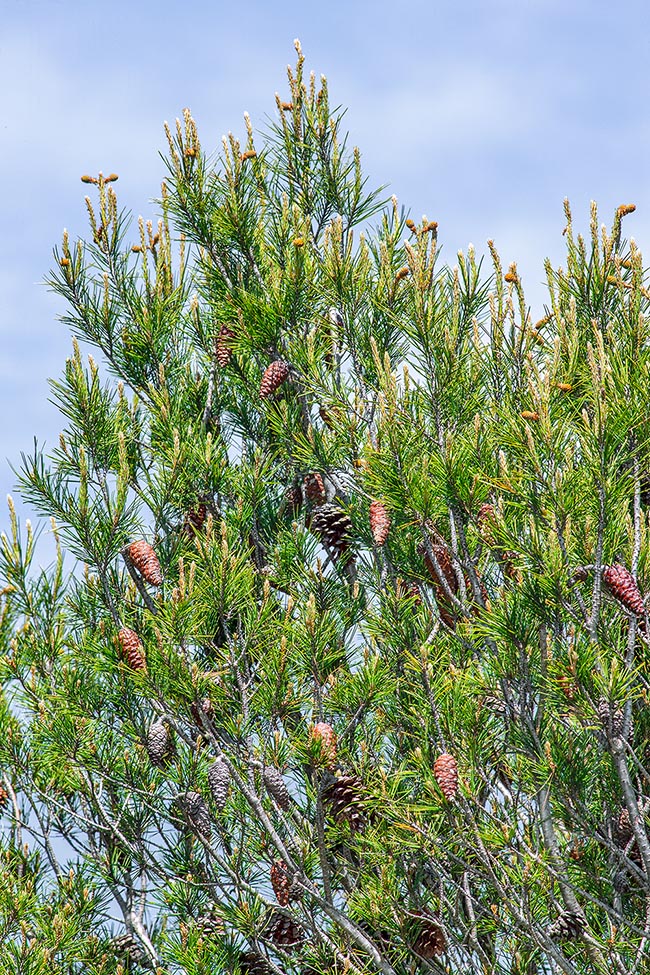
Crown of Pinus halepensis loaded with cones ad various developmental stages. The ripening of seeds occurs in the autumn of the second year and dissemination could begin in the following year but, winter but most cones do not open for several years remaining on the tree or, closed, on the ground (serotinous cones) © Giuseppe Mazza
Since the male cones are located exclusively at the base of the year’s branch, it is easy to verify the number growth flushes per year from the position of the male cones or their scars left.
Aleppo pine is a heliophilous and xerophilous species; even if it gives preference to calcareous one, it does not have particular requirements to other soils avoiding only those too humid or excessively clayey; it requires a climate characterized by a prolonged drought in the summer and by mild and rainy winters (temperate Mediterranean climate); it is a very well tolerating the marine aerosols.
During the last glaciation the Aleppo pine had found refuge in the south-eastern regions of the Balkan Peninsula but thanks to its ecological plasticity, due to the low demand for soil type, to its pioneering and, overall, its being a highly specialized pyrophyte, it has been able to expand rapidly in central and northern Mediterranean along the European and North African sides. Then, man has spread it all over the Mediterranean basin, introducing it also in California, in South America and in South Africa. It is present in the Mediterranean regions of Spain and France, in the first from Catalonia to Andalusia whilst in France whilst in France it is mainly present in the Midi and, in particular, in the departments of the Région Sud where the pine forests of Aleppo have taken on a special landscape importance (just think of the attraction that they e had for Paul Cézanne); it was instead introduced in Corsica. In Italy it is present along several coasts of the peninsula and of the islands; even if with doubts about its possible anthropic origin, it is present in Umbria near Spoleto. The same doubts have been advanced also for the pinewoods of the Gargano and those of Taranto.
Yore, its wood, very resinous and heavy, were used in carpentry and in ship constructions (e.g. the beams of the roman vessels found on the bottom of Lake Nemi had been obtained from trunks of this species). Nowadays thr wood of this pine has lost interest as lumber but is still required for the production of paper or to obtain firewood and energy.
A medium-sized Aleppo pine can produce 3-4 kgper year of resin which is used to get from it turpentine and derivatives (turpentine essence and rosin) as well as to produce varnishes, creams for footwear, waxes for floor, to aromatize soaps and sinthetize camphor and to prepare products for cosmetics and phytoterapy. In the Middle East the resin, as it is, is employed for fishing gears and in the preservation of food and drinks and in Greece is also used for the production of ‘Retsina’, a very common wine flavoured with this resin.
The P. halepensis forests are advantageous to improve the quality of the environment both by creating windbreak barriers useful to mitigate the wind, especially against the marine aerosols, and by maintaining the stability of the soils thanks the tree canopies suitable to intercept the rain, thus attenuating the consequences of the force of the water drops on soil particles, and thanks to the root system wich, besides containing the movements of the soil, facilitate the conveyance of the water towards into subsoil, furthemore, pines provide a pleasant shade to animals, humans being included. In the last decades, especially in the coastal touristic zones, this pine is employed in garden and landscape design.
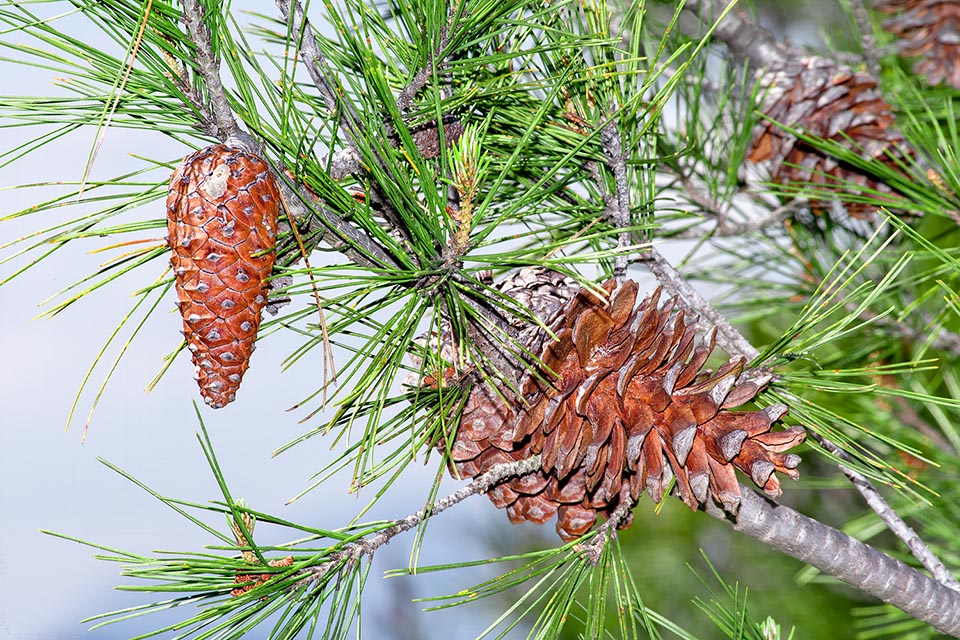
Most of cones are called serotine, from Latin “serotinus”, tardy, as often they fall down on the ground still closed or they remain as such on the tree, greyed even for many years awaiting a fire. Only then seeds are freed by heath, are sure to find a soft and fertile soil without competitors. A strategy to give seedling most possibilities to succeed © Giuseppe Mazza
Aleppo pine is more or less affected by the same pathogens that cause damages to other pines and that at times can, locally, and in presence of stressful situations, create problems for some years. In this context one of the most harmful is the pine processionary (Thaumetopoea pityocampa), a moth whose larvae defoliate seriously the pines; harmful are also other lepidopterans, aphids and cochineals. In the latter group, Matsucoccus josephi is causing serious damages to Middle East pinewoods of its related P. brutia.
In recent years it has come in the Mediterranean basin Leptoglossus occidentalis, a very large bug of North America that destroys the pine cones. Among fungal diseases, sometimes even widespread damages may be due to Sphaeropsis sapinea that, at early spring, causes by the desiccation of the very young twigs (‘shoot blight’) and to Xanthochruos pini and to other agents of decay of root rots. Among the abiotic factors, the increase of the ozone is causing diffuse conditions of stress in several populations.
From the time when, in the early XIX century, Michele Tenore (1780-1861), important Neapolitan botanist, named Pinus brutia Ten. (1815) a new species of pine founded on the mountains of Calabria to highlight that it grew in that part of Calabria called “Bruttium” by the Romans, have begun the discussions if this taxon had to be considered as a species by itself or if it was, instead, a subspecies of P. halepensis. From this century onwards analytical methodologies bases on the comparison between morphological characters and molecular markers have allowed to better clarify the problem and nowadays the trend, albeit with conflicting voices, is to consider the two taxa as close but separated species.
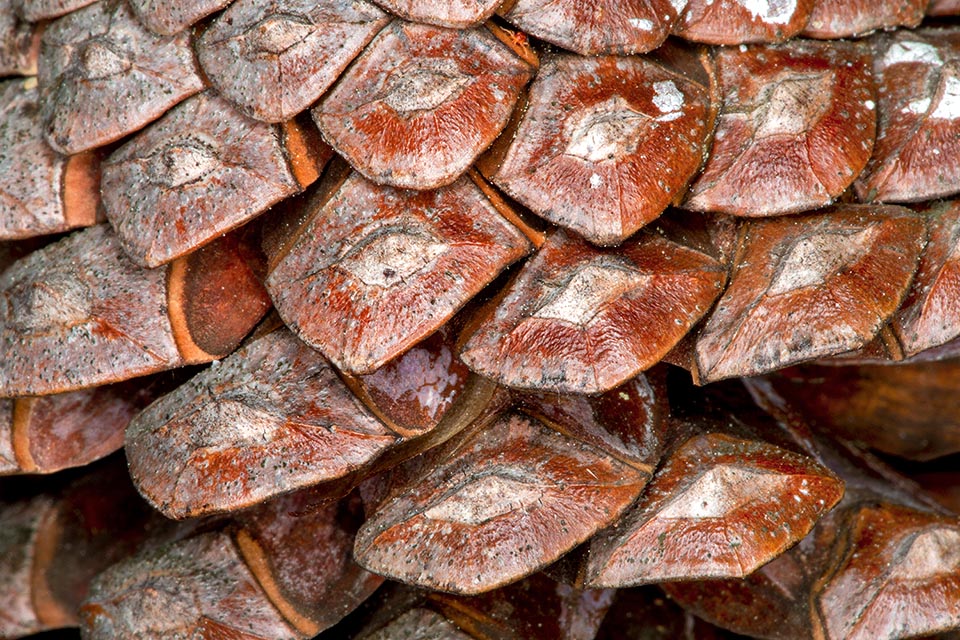
In pine cones the visible part of the scale has a rhomboid profile called apophysis. In Aleppo pine it is flat with just hinted transversal keel and umbo © Giuseppe Mazza
The discriminating characters are:
– shape of the trunk normally short, twisted and rapidly branched in the Aleppo pine; straight and slender in the Calabrian pine;.
– size of needles: (5) 7-10 (12) cm long and 0,7-1 mm broad in the Aleppo pine; 10-16 cm long and 1-1,5 mm broad in the Calabrian pine;
– peduncle of the cone: 10-20 mm long and more or less curved in the Aleppo pine; sessile or subsessile in the Calabrian pine;
– cone: usually pendulous in the Aleppo pine; erect or horizontal in the Calabrian pine;
– seeds: 5-7 mm long in the Aleppo pine; 6-9,5 mm long in the Calabrian pine.
For many centuries the forests of Aleppo and Calabrian pine were burnt, cut and then cultivated or replanted. Despite this, their distribution ranges have remained quite distinct: Aleppo pines occupy the central and western sides of the Mediterranean Sea, with sporadic presences in the eastern one, the Calabrian pines live instead in the eastern one, from the Greek and Anatolian peninsulas to Syria up to Palestine; it is also present with isolated populations in the northern part of Black Sea and in the Caucasus region.
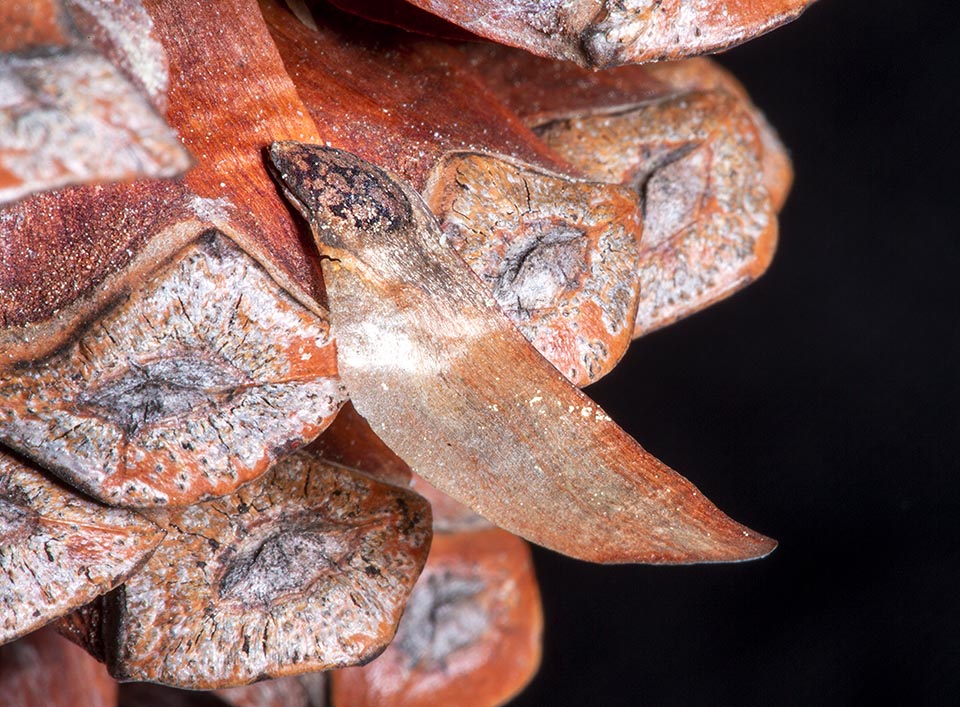
Seed getting out from the scale of a pine cone. Has one very long wing, for better anemophilous dispersion © Giuseppe Mazza
In this distinction of taxa and ranges a onomastic curiosity has come to be created: Aleppo pine was named in 1768 by Philip Miller «halepensis», as spontaneous in the surroundings of Aleppo. But this species was not present in that region. With an almost identical criterion, Calabrian pine was named in 1815 by Michele Tenore «brutia» but instead this pine is not spontaneous in Calabria although it is possible that over the centuries this pine it has been introduced to this region and Michele Tenore, finding it, thought it was spontaneous.
Between the two species the Calabrian pine has a greater forest interest having a better quality and greater resistance to cold.
Some varieties, geographically well defined are attributed to P. brutia: P. brutia var. pithyusa (Steven) Silba present on the coasts of the Black Sea, from Georgia to Crimea, P. brutia var. pendulifolia Frankis in the Turkish province of Muǧla in front of the island of Rhodes and P. brutia var. eldarica (Medw.) Silba in Transcaucasia (Azerbaijan and Russian Azerbaijan).
Since P. brutia has been separated from P. halepensis, the latter does not have subspecific taxa.
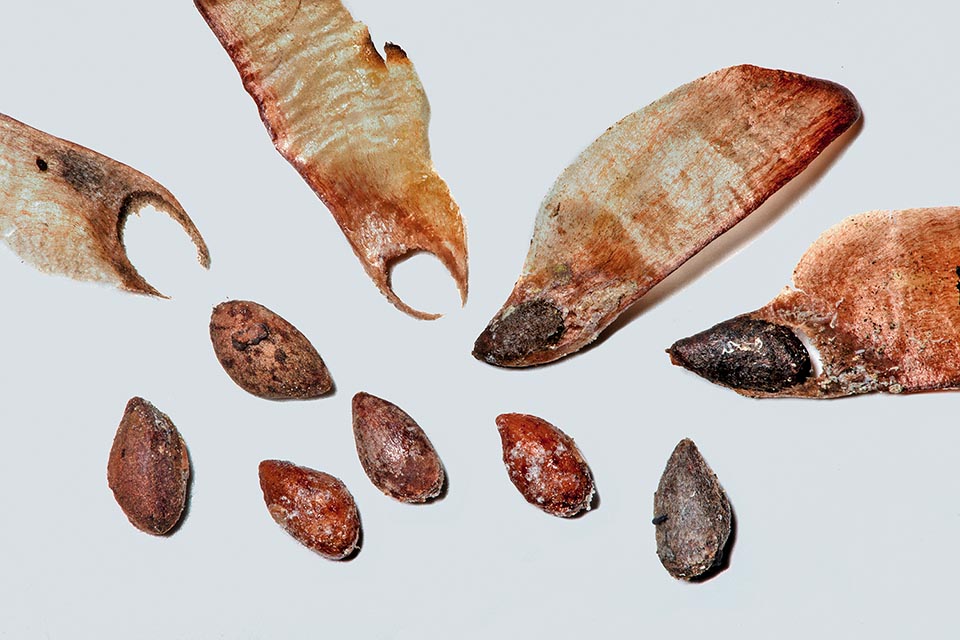
Seed without wing near others winged and two wings devoid of their respective seeds. Apart from forestry uses, a medium-sized Aleppo pine can in one year 3-4 kg of resin, used for getting turpentine and varnishes derivatives, creams for footwear and waxes for floor. Served also to flavour soaps or drinks and in phytotherapy © G. Mazza
Synonyms: Pinus halepensis Mill. subsp. halepensis 1768; Pinus maritima Mill. 1768; Pinus sylvestris L. var. maritima Aiton 1789; Pinus alepensis Poir. 1804; Pinus penicillus Lepeyr. 1813; Pinus maritima Aiton non Mill. 1813; Pinus halepensis subsp. brutia Ten. 1815; Pinus arabica Sieber ex Spreng. 1826; Pinus genuensis S.E.Cook 1834; Pinus hispanica J.Cook 1834; Pinus halepensis Mill. var. genuensis (S.E.Cook) Antoine 1840; Pinus halepensis Mill. var. minor Antoine 1840; Pinus carica D.Don 1841; Pinus abasica Carrière 1855; Pinus halepensis Mill. var. carica (D. Don) Carrière 1855; Pinus loiseleuriana Carrière 1855; Pinus pseudohalepensis Denhardt ex Carrière 1855; Pinus parolinii Vis. 1856; Pinus halepensis Mill. var. abasica (Carrière) Carrière 1867; Pinus ×saportae Rouy 1913; Pinus saportae Rouy 1913; Pinus halepensis subsp. brutia (Ten.) Holmboe 1914; Pinus halepensis var. ceciliae (Llorens & L.Llorens) L.Llorens 1979; Pinus halepensis subsp. brutia (Ten.) A.E.Murray 1983; Pinus halepensis subsp. pithyusa (Steven) A.E.Murray 1983; Pinus halepensis subsp. stankewiczii (Sukaczev) A.E.Murray 1983; Pinus ceciliae Llorens & L.Llorens 1984; Pinus halepensis var. ceciliae (Llorens & L.Llorens) L.Llorens ex Rosselló, Cubas & N.Torres 1992; Pinus halepensis var. pendula P.P.Ferrer & R.Ferrer 2014.
→ To appreciate the biodiversity within the PINACEAE family please click here.
